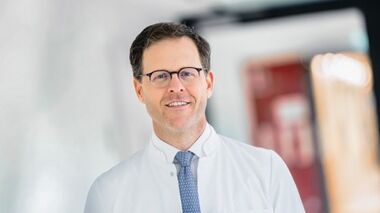Professor Dr. Christoph Michalski is the new Medical Director of the Department of General, Visceral and Transplant Surgery at Heidelberg University Hospital
As successor to the renowned Professor Dr. Markus W. Büchler, Professor Michalski takes over one of the most traditional clinics in Germany with state-of-the-art equipment, more than 300 surgical beds and a very broad spectrum of treatment. His main areas of expertise include complex surgical oncology, including in particular the field of surgery for metastases and recurrent tumors, minimally invasive and robot-assisted surgery, the development of AI-assisted treatment concepts, and transplant medicine. He also plans to further expand the European Pancreas Center and the Transplant Center at Heidelberg University Hospital in interdisciplinary cooperation.
"The Surgery Center at Heidelberg University Hospital is one of the leading institutions in Germany and Europe. Professor Michalski will further expand the clinic's focus on pancreatic, liver, esophageal, gastric and intestinal surgery, as well as transplant surgery, and will lead new minimally invasive as well as robotic and AI-assisted procedures into clinical application and further develop the role of surgery in multimodal therapy concepts for complex diseases such as cancer," says Professor Dr. Ingo Autenrieth, Chief Medical Director and Chairman of the Board of Directors of Heidelberg University Hospital.
Establishment of an interdisciplinary abdominal center planned
One of Professor Michalski's heartfelt topics is interdisciplinary medicine. He is specifically concerned with the establishment of an abdominal center with an interdisciplinary visceral medicine and visceral oncology ward in cooperation with the Clinic for Gastroenterology, Infectious Diseases and Poisoning as well as the Clinic for Medical Oncology and the National Center for Tumor Diseases (NCT), which is also located in Heidelberg.
"Therapies are becoming increasingly multimodal, which means that surgery is part of a chain of therapy that must be adapted as precisely as possible to the individual patient and his or her disease pattern. Close cooperation not only with other surgical disciplines, but also with radiotherapy, internal medicine, the NCT and the scientists at the German Cancer Research Center (DKFZ) is therefore an important concern for me," says Professor Michalski.
Around 40 percent of all operations - from surgery on the gall bladder to very complex tumor operations on the pancreas - are already performed minimally invasively, i.e. using so-called keyhole surgery, at the Department of General, Visceral and Transplant Surgery at Heidelberg University Hospital. "Together with my team, I would like to increase this proportion even further and further expand the spectrum," says Professor Michalski. "In this context, surgical robots are playing an increasingly important role, but close interpersonal exchange within the team is also particularly important in order to achieve the best for our patients together."
The Surgery Center at Heidelberg University Hospital
The surgery center accommodates the departments for general, visceral and transplant surgery, cardiac surgery, vascular surgery, urology, anesthesiology and radiology.
Building Highlights
- The core of the surgery center is the operating wing with 16 operating rooms, which will be digitally embedded in the clinic's medical and IT landscape.
- Six operating rooms are equipped with integrated endoscopy systems and two operating rooms as hybrid operating rooms with robot-assisted angiography systems.
- There is also an outpatient operating area, a day clinic, radiological functional diagnostics and outpatient departments.
- The helicopter landing platform on the roof is of central importance for the entire hospital.
- A lecture hall with 196 seats and seven seminar rooms are available for research and teaching on an area of around 900 square meters.
- In addition to the five normal nursing wards with 36 beds each, there are two intensive and two intermediate care wards with each a maximum of 28 beds and a station for elective medical services with 21 beds. Thus, a total of 313 beds.
Technology Highlights
- Around 6,000 medical devices are in use.
- In the centrally located emergency room connected to the operating area, important information on emergency patients is transmitted directly from the emergency services, recorded centrally and continuously updated and displayed on large screens.
- A “Fast Track Computed Tomograph (CT)” is integrated here. Vital signs can be recorded centrally via patient monitoring and retrieved at any time when changing the ward.
- In the two hybrid operating rooms, both open and minimally invasive vascular surgery can be performed.
- The operating area is fully digitized and networked, robot-assisted imaging techniques and a 3-Tesla Magnetic Resonance Tomograph (MRT) are available.


